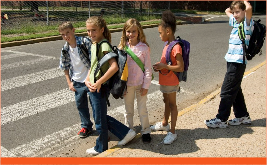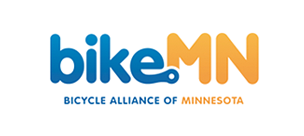
The Minnesota Mayoral Active Transportation Caucus was created to highlight the importance of pedestrian and bicycle infrastructure and programs to the communities of Minnesota. It also strives to ensure that funding for the MnDOT Active Transportation Grant Program is included in transportation funding packages.
The Caucus is co-chaired by Mayor Maria Regan Gonzalez of Richfield, Mayor Kim Norton of Rochester, and Mayor Jed Shaw of Walker. The caucus consists of Greater Minnesota and suburban-based mayors who understand the need for and importance of investing in quality pedestrian and bicycle infrastructure outside the urban core of the Twin Cities metro area. You’ll find a list of the caucus members further down this page.
Our state needs to make significant investments to update its transportation system. This is an opportunity to make sure that not only are our roads, bridges, and transit systems are improved, but that our communities have the resources necessary to update and modernize infrastructure and provide programs to meet the needs of pedestrians and bicyclists as well. These needs include safety, business and economic opportunities, and of course improved health and environmental benefits.
This caucus will serve as a nonpartisan resource for legislators who represent constituencies throughout Minnesota. This Caucus was organized in part by the Minnesota Safe Routes to School Coalition, the Bicycle Alliance of Minnesota, and the Minnesotans for Healthy Kids Coalition, which is comprised of health- and transportation-based organizations, and others. The League of Minnesota Cities and the Regional Council of Mayors also provided assistance in forming this caucus.
Want more information?
Read this one page fact sheet that makes a strong case for increased pedestrian and bicycle investment in Minnesota.
Want your mayor to get more information about the caucus? Email info@bikemn.org and we’ll be sure to reach out to them! And, please let us know if you can commit to a follow-up call or email after they get the invitation.
Mayors can sign up to be a part of the caucus here.

Frequently Asked Questions
Caucus Members
Co-Chairs
Maria Regan Gonzalez, Richfield
Jed Shaw, Walker
Kim Norton, Rochester
Mayoral Members
Thomas Stiehm, Austin
Rita Albrecht, Bemidji
Terri Collins, Benson
Mary Wingfield, Birchwood Village
Dave Bartholomay, Circle Pines
Jerry Koch, Coon Rapids
Emily Larson, Duluth
James Hovland, Edina
Ben Schierer, Fergus Falls
Shep Harris, Golden Valley
Jay Arrowsmith DeCoux, Grand Marais
Dave Smiglewski, Granite Falls
Steve Donney, Harmony
Bob Anderson, International Falls
George Tourville, Inver Grove Heights
Jon Lubke, Jenkins
Mike Poellinger, La Crescent
John Keis, Little Canada
Bob Byrnes, Marshall
Lois Nelson, Medford
Ronald Anderson, Milan
Sheldon Giese, Morris
Robert Beussman, New Ulm
Fred Froehlich, Nicollet
Rhonda Pownell, Northfield
Mark Dehen, North Mankato
Suzanne Hilgert, Olivia
Thomas Kuntz, Owatonna
Brent E. Frazier, Pelican Rapids
Tim Meehl, Perham
Chad Ward, Proctor
Sean Dowse, Red Wing
Tom Quackenbush, Redwood Falls
Andrea Lauer, Royalton
Sandy Martin, Shoreview
Scott Zerby, Shorewood
Jeromy Rockvam, Spring Park
Dave Kleis, St. Cloud
Jake Spano, St. Louis Park
Duane Willenbring, Rockville
Emily Durand, Wabasha
Jo Emerson, White Bear Lake
Marv Calvin, Willmar
Mark Peterson, Winona
Mike Kuhle, Worthington
Why is the caucus needed?
When people and policymakers refer to investing in transportation, the common interpretation is roads, bridges, and transit. While Minnesota needs to repair and improve its network of roads, bridges, and transit systems, the state also needs to invest in improving all modes, including its pedestrian and bicycle infrastructure. The most efficient and cost-effective time to improve nonmotorized infrastructure is often when roads and bridges are also being improved and rebuilt. The caucus will advocate for funding for improved pedestrian and bicycle infrastructure and programs. It will share that bicycling and walking is important throughout the state. The Caucus exists to serve as a resource for legislators from throughout Minnesota.
What is the Minnesota Mayoral Active Transportation Caucus?
The Caucus was created to increase awareness that walking and bicycling are important to communities statewide, as well as to advocate for the need to include pedestrian and bicycle infrastructure and programming as part of transportation funding. The caucus consists of Greater Minnesota and suburban-based mayors for whom pedestrian and bicycle infrastructure and programs are important components of their communities.
What does this effort have to do with transportation funding?
Minnesota is likely on the cusp of making significant investments to update the state’s transportation system. This is an opportunity to make sure that not only are our dated roads and bridges rebuilt and improved, but that our communities have the resources necessary to update and modernize our infrastructure and programming to meet the needs of pedestrians and bicyclists as well – needs that include safety; business, economic, and quality of life opportunities; and improved health and environmental benefits.
Why is this a mayor-only caucus?
Mayors are community leaders who represent the vision for their cities. They are keenly aware of just how extensive the needs are for Minnesota’s transportation system and the need to include funding for active transportation. Mayors live and work in the communities that will be on the receiving end of any transportation funding package approved by the Minnesota Legislature.
What is “active transportation?”
Active transportation refers to getting around by expending human energy – primarily walking and bicycling. Active transportation infrastructure can include sidewalks, safer street crossings, bicycle routes and trails, and street and sidewalk lighting.
Isn’t there already an Active Transportation Grant Program in MnDOT?
Yes, the program was created by the Legislature and signed into law in 2017. BUT IT HAS NEVER BEEN FUNDED!
Why is the caucus focusing on Greater Minnesota and the suburbs?
In past legislative debates, pedestrian and bicycle needs have sometimes been characterized as primarily Twin Cities metro-centric. In addition, bicycling is often viewed and described as solely a recreational pursuit, rather than a growing form of transportation for Minnesotans and their families throughout the state. As Greater Minnesota and suburban mayors, the caucus can attest to just how extensive the needs are for Minnesota’s transportation system, including pedestrian and bicycle infrastructure. They can also discuss the growing importance of bicycling to communities throughout Greater Minnesota.
What are the active transportation needs of Greater Minnesota?
The active transportation needs of Greater Minnesota are significant. City and county leaders in Minnesota have reported a backlog of $1.3 billion in projects for sidewalks, curb ramps, safer intersections, and bike routes and trails. MnDOT currently estimates it will have only half the revenue needed for pedestrian and bicycle investments in the state’s trunk highway corridors alone. In addition, the federal Transportation Alternatives Program (TAP) funding also cannot meet demand—during the last rounds of funding, Minnesota applicants sought tens of millions to construct pedestrian and bicycle projects, but typically less than one-quarter to one-third is available.
Why is it important to invest in active transportation infrastructure?
Active transportation brings huge benefits to Minnesota. Those benefits include increased safety, improved health and locally based economic development opportunities and environmental benefits. For example, in 2013, 11% of traffic fatalities in Minnesota involved people who were walking or bicycling and more than 1,680 pedestrians and bicyclists were injured, due in part, to safety issues. In 2013, 26% of Minnesota adults were obese and 36% were overweight. In addition, 27% of Minnesota’s youth between the ages of 10 and 17 are overweight or obese, due largely to a lack of physical activity. Walking and biking routes are important community assets that have become an economic development engine and a means of attracting and retaining residents and a strong workforce in many communities throughout Minnesota. Several of Minnesota’s internationally known brands have been recognized nationally as Bicycle Friendly Businesses—such as 3M, General Mills, and Target—along with more than 75 other businesses, including more than 50 in Greater Minnesota.
Does the caucus support funding for roads and bridges?
Absolutely. Minnesota needs to rebuild its system of roads and bridges. But it also needs to improve the active transportation network and teach people to use it safely, thereby helping to increase safety, health, and economic opportunities for Minnesota’s communities. The most efficient and cost-effective time to improve and develop pedestrian and bicycle infrastructure is when roads and bridges are also being improved and rebuilt.
